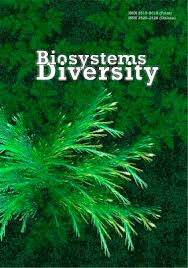Taxonomic and ecological composition of the native groupings of the birds of the dry steppe zone of Ukraine
Taxonomic and ecological composition of the native groupings of the birds of the dry steppe zone of Ukraine
Author(s): Y. O. AndryushchenkoSubject(s): Agriculture, Regional Geography, Environmental Geography
Published by: Дніпропетровський національний університет імені Олеся Гончара
Keywords: vulnerable species; ornithofaunistic complexes; topomorphs; landscapes; habitats;
Summary/Abstract: The classifications of the grouping of the birds reflect the faunistic or the ecological position of the species in certain habitats and landscapes. Most of them consider the species diversity of the birds of the studied regions in general, including synanthropic, invasive and widespread species. This approach prevents singling out the habitats which are important for supporting the existence of native (or autochtonous) species and their groupings. Native groupings of the birds in the dry steppe zone of Ukraine are almost not studied despite the rapid contraction in the range and population of most component species, especially Anthropoides virgo, Otis tarda, Tetrax tetrax and Burhinus oedicnemus. The definition of the taxonomic and the ecological composition of these grouping will help in understanding the strategy of the reproduction and the protection of native avifauna. In connection with this, the faunistic-topomorphic classification of native birds in the dry steppes zone of Ukraine according to the following scheme is proposed: ornithofaunistic complex (by priority landscapes and habitats) – the place of the feeding (by priority substrate on/in which a species’ diet is extracted) – the nesting place (by the priority substrate of the location of the nest for nesting individuals) – the place of rest (the priority substrate where non-nesting individuals rest). The classification is aimed at the definition of the general requirements of native birds and their groupings in terms of the landscapes and the habitats which provide the conditions for their preservation and the protection in the researched region. It has been determined that in the south of Ukraine 33 nesting species are dry-steppe autochthons (18.3% of nesting species of the region), of which 18 species form the ornithofaunistic complex of dry steppes (Buteo rufinus, Perdix perdix, Anthropoides virgo, Otis tarda, Tetrax tetrax, Burhinus oedicnemus, Glareola nordmanni, Galerida cristata, Calandrella cinerea, C. rufescens, Melanocorypha calandra, Anthus campestris, Motacilla feldegg, Saxicola rubetra, S. torquata, Oenanthe oenanthe, Oe. isabellina, Emberiza melanocephala), and 15 species form the complex of the sea coast (Phalacrocoraх aristotelis, Phoenicopterus roseus, Tadorna ferruginea, T. tadorna, Mergus serrator, Charadrius alexandrinus, Recurvirostra avosetta, Larus ichthyaetus, L. melanocephalus, L. genei, L. cachinnans, L. michahellis, Gelochelidon nilotica, Hydroprogne caspia, Thalasseus sandvicensis). The above-mentioned species are mainly xerophiles (54.6% of species) and hygrophils (24.2% of species), and they are in the most threatened position because they feed, nest and rest mainly or exclusively on the soil surface. According to the proposed classification, native birds of dry steppes require: for xerophiles – areas of soil without vegetation or with rarefied low grass, which does not prevent birds from moving freely, searching and obtaining food, leading their chicks, looking over their territories; for hygrophiles – shallow water bodies with islands, surface vegetation, shallows, adjacent meadows and salt-marshes; for dendrophiles – single shrubs and trees or small groves; for most xerophiles and dendrophiles – fresh or slightly saline water bodies for drinking. Unfortunately, in the protected natural territories of the researched region, most native birds do not have this combination of the above-mentioned habitats, which are simultaneously suitable for feeding, nesting and resting.
Journal: Biosystems Diversity
- Issue Year: 29/2021
- Issue No: 3
- Page Range: 225-234
- Page Count: 10
- Language: English

